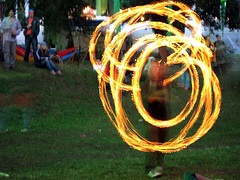In my last post I talked about Nearpod, a presentation/assessment app that I liked, but ultimately found lacking. My experience with Nearpod has reawakened in me a concern I've had for some time, both as trainer and Superintendent of a tech-forward school system. Helping teachers to effectively use tools that are coming into our classrooms is a great thing, but how do we prepare them for five years from now when the tools and techniques will be different again?
During the past month I've done several trainings for teachers in my Diocese. I've enjoyed these very much, and it has excited and encouraged me to see the willingness of teachers in all phases of their careers to embrace new tools. My current training model stresses functions over apps, though I demonstrate a few of the apps (Socrative, Educrations) that I find easy really transformative. Following up on some of these sites, I've been gratified to see these being regularly used in classrooms. Despite the fears of some naysayers, teachers ARE getting it. Given a clear structure and limited apps, any teacher can use 1:1 devices to effectively improve instruction. I know that as these pioneers grow in confidence that this classroom experience will improve and grow.
But what about Nearpod and the many Nearpods to come? Are teachers developing not only the set skills but the flexibility to continue assessment and growth into new devices and new applications? Here I'm not so sure. My idea of teaching limited apps is to create a “safe” environment for building, but what if one of these apps should disappear, or if a school should change devices? Are we creating the flexibility to adapt what has been learned onto a new canvas?
It is a cliche of the edtech world that we are preparing children for a future that doesn't yet exist and that we can't imagine. The same can be said for teachers. The future of the classroom is being rewritten every day, and we need to develop expectations and structures for growth. Educational technology is not a body of knowledge; I don't know that there are any “bodies” of knowledge anymore. There are no clear boundaries and tomorrow laughs at mastery.
Many schools are doing a good job with this by setting up learning communities for ongoing assessment and development of all classroom skills. But a local community is limited by the capacity of the individuals, and in a small environment there may not be enough drivers to pull the entire organization. We need to teach schools how to reach out beyond their environment and to never stand still, and we need to instill in teachers the expectation of this change.
How do you teach flexibility? If you know, please tell me.
As always, I invite your comments
Image: 'Firedancers' http://www.flickr.com/photos/31067114@N00/234983562 Found on flickrcc.net

I learned to be flexible when I worked at the editing facility. In 3 years the whole video post production world turned upside down before my eyes-there was change daily. I often say I am so flexible now I could join Cirque de Soleil. I don’t think it’s something that can be taught. It’s a mindset you just have to get to at a certain point in your career.